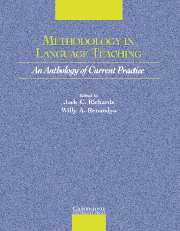Book contents
- Frontmatter
- Contents
- Acknowledgments
- Introduction
- Section I Approaches to Teaching
- Section 2 Lesson Planning and Classroom Management
- Section 3 Classroom Dynamics
- Section 4 Syllabus Design and Instructional Materials
- Section 5 Task and Project Work
- Section 6 Learning Strategies
- Chapter 11 Language Learning Strategies in a Nutshell: Update and ESL Suggestions
- Chapter 12 Learner Strategy Training in the Classroom: An Action Research Study
- Section 7 Teaching Grammar
- Section 8 Teaching Pronunciation
- Section 9 Teaching Speaking
- Section 10 Teaching Listening
- Section 11 Teaching Vocabulary
- Section 12 Teaching Reading
- Section 13 Teaching Writing
- Section 14 Assessment
- Section 15 Technologies in the Classroom
- Section 16 Professional Development
- Credits
- Author Index
- Subject Index
- References
Chapter 11 - Language Learning Strategies in a Nutshell: Update and ESL Suggestions
Published online by Cambridge University Press: 10 November 2010
- Frontmatter
- Contents
- Acknowledgments
- Introduction
- Section I Approaches to Teaching
- Section 2 Lesson Planning and Classroom Management
- Section 3 Classroom Dynamics
- Section 4 Syllabus Design and Instructional Materials
- Section 5 Task and Project Work
- Section 6 Learning Strategies
- Chapter 11 Language Learning Strategies in a Nutshell: Update and ESL Suggestions
- Chapter 12 Learner Strategy Training in the Classroom: An Action Research Study
- Section 7 Teaching Grammar
- Section 8 Teaching Pronunciation
- Section 9 Teaching Speaking
- Section 10 Teaching Listening
- Section 11 Teaching Vocabulary
- Section 12 Teaching Reading
- Section 13 Teaching Writing
- Section 14 Assessment
- Section 15 Technologies in the Classroom
- Section 16 Professional Development
- Credits
- Author Index
- Subject Index
- References
Summary
INTRODUCTION
In learning ESL, Trang watches TV soap operas from the United States, guessing the meaning of new expressions and predicting what will come next. Feng-ji memorizes pages of words from an English dictionary and breaks the words into their components. Amany meets with an English-speaking conversation partner for lunch three times a week. Haruko arranges to live with an American family so she can learn the culture and language in a full-time immersion situation. Masha tapes English labels to all the objects in her dorm room. Marcel practices song lyrics in English, moving freely to the music while singing. Luis regularly reads Newsweek, the New York Times, Parade, and even American comic books. Boris draws pictures of new words and creates flow charts showing how they fit together semantically. Marie-France uses a green highlighting pen to mark the main points in the notes she takes in class, and later she outlines the notes and writes a summary. Jing-Mei, who is afraid to speak English, encourages herself by using positive affirmations and self-praise. Hermann keeps a diary to evaluate his daily performance in learning English.
All these people are employing language learning strategies – specific actions, behaviors, steps, or techniques that students (often intentionally) use to improve their progress in developing L2 skills. These strategies can facilitate the internalization, storage, retrieval, or use of the new language. Strategies are tools for the self-directed involvement necessary for developing communicative ability.
- Type
- Chapter
- Information
- Methodology in Language TeachingAn Anthology of Current Practice, pp. 124 - 132Publisher: Cambridge University PressPrint publication year: 2002
References
- 34
- Cited by

